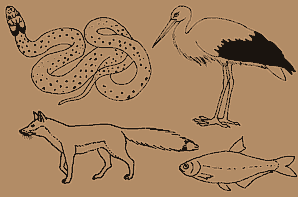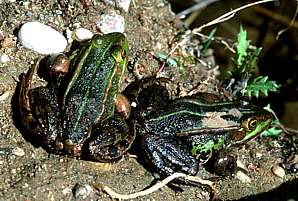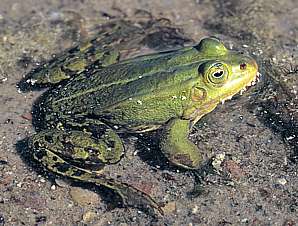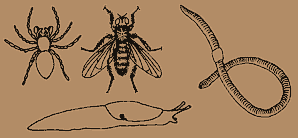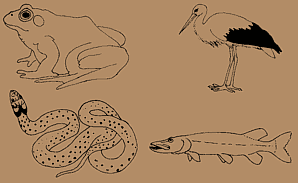|
AMPHIBIANS
|
||||||||||||||||||
Text:
|
Frogs
FROGS Rana are amphibians with long, vivacious legs and well developed natatorial membranes, possess relatively smooth, moist skin and well developed tympanic membranes. There are six species of frogs in Poland, whereas the edible frog is often regarded to be a fertile crossbreed created in the course of crossbreeding of a pond frog and a marsh frog. They are conventionally divided into the "green frogs" - that is pond frog Rana lessonae, edible frog Rana "esculenta" and marsh frog Rana ridibunda with a prevailingly water course of life and the "brown frogs" - that is moor frog Rana arvalis, common frog Rana temporaria and agile frog Rana dalmatina. Four species of these frogs were noted in the area of the Wigry National Park (there is no marsh frog and no agile frog).
Moor frog and common frog are observed in Europe and in Asia; they are common in all kinds of environments in Poland. It is also observed also on the whole area of the Wigry National Park. For its mating areas it selects smallish water reservoirs with clean water, covered with reed, cattail, and bulrush. Beyond its mating season, it stays in coniferous and deciduous forests as well as in meadows.
Moor frog is a little smaller than common frog, reaching the length of 8 centimetres, while the common frog reaches the length of even 10 centimetres. The end of the muzzle of the moor frog is narrowing and visibly sharpened while at common frog it is bluntly rounded. Pigmentation of brown frogs is very changeable. Generally saying, the dorsal part of the body is prevailingly pigmented with a brown colour, spots have a darker colour, which often is black. The ventral part of the body is often pigmented with a yellow or whitish colour and the spots - which are also present there - are less visible at a moor frog and more visible at a common frog. There is a very distinct marking of the so-called "mask" - that is a black temple spot, linked with nasal spots in front of the muzzle.
During the mating season, males produce mating calluses (these are black pachynses on the toes of the front limbs) and resonators in even number inside the oral cavity. Moreover, the back of males of a moor frog adopts intensively blue colour during the mating season. Males of a common frog adopt bluish or blue-lilac pigmentation of their skin in the dewlap area.
Common frog wakes up from hibernation in February or at the beginning of March while moor frog at the end of March or at the beginning of April. Males appear in water - where mating will take place - much earlier than females. They are very excited then and continuously utter mating calls. Coupled pairs fall down to the bottom of the reservoir where females spawn clusters of frogspawn. Eggs are black from one side and white on the other side. Tadpoles of these both species of brown frogs are difficult to distinguish between, especially at the initial stage of development. Grown-up tadpoles of a moor frog are much darker (they are actually almost black) in comparison to tadpoles of a common frog. The development lasts 2,5-3 months on average at a moor frog and 2 - 4 months at a common frog.
A moor frog exhibits diurnal activity, while a common frog (that is mainly adult specimens) exhibits nocturnal and crepuscular activity. Moor frogs hibernate in scattering on land, in piles of rotting leaves, in rotten wood while common frogs hibernate in groups, mainly buried in silt in the bottom of streams and smaller rivers while only juvenile specimens hibernate on land.
Nourishment of brown frogs includes the following species: earthworms, myriapodans, arachnids, heteropters, beetles, flies, butterflies and ants. Additionally, it also eats certain amounts of plant nourishment (mainly leaves and seeds).
Main natural foes of brown frogs include the following species: cyprinid fish, grass snake, stork, heron and some predatory species - foe example: fox, badger, otter, marten and hedgehog.
Edible frog and pond frog are present in the central and Eastern Europe. They are common in the whole area of Poland, especially in lowlands. They inhabit all sorts of environments, however, edible frog is mainly observed in larger ponds and lakes rich in water vegetation and much more seldom at riverbanks while a pond frog inhabits small and medium sized water reservoirs just like forest and field ponds, melioration ditches, flood waters in boggy meadows. Edible frog is often present in the area of the Wigry National Park in larger lakes such us: the Wigry lake, the Pierty lake, the Królówek lake while pond frog is often seen in smallish dystrophic lakes - that is so called "suchar". The dorsal part of the body of green frogs has a grass-green pigmentation; there is a light coloured line across this section of the body, there are no temple spots. The ventral side of the body is whitish, usually covered with greyish spots.
An edible frog exhibits typically diurnal activity and - contrary to its name - is a more land-like form in comparison to a pond frog. An edible frog is a large, stocky amphibian which reaches the length of 10-12 centimetres while a pond frog is smaller and much more delicate and reaches the length of only 7,5-8 centimetres.
During the mating season, males of green frogs develop so called mating calluses - these are black pachynses on the toes of the front limbs - and resonators in even number - large, membrane-like, greyish sound bags.
Green frogs start their mating quite late - in May and June. While the weather is warm, males attend choral singing - both at day and at night. Coupled pairs fall down to the bottom of the reservoir where females spawn frogspawn, attaching it to water plants. After some time, such clusters come up to the surface of water. Due to the fact that both pond frogs and edible frogs are often present in the same water reservoirs, and periods of their mating seasons are partially coherent, therefore coupling of specimens of various species happens more than occasionally, ending with placing fertilized eggs. Adult green frogs hibernate only at the bottom of flowing waters; young specimens however, hibernate on land.
Green frogs feed on mainly insects, such as: flies, insects from the suborder of Aculeata, dragonflies, and beetles, moreover, they also eat earthworms, arachnids and snails. Larger specimens also eat larger animals such as mole crickets, smaller cyprinid fish, adult newts, other frogs (also of the same species), lizards, young blindworms, snakes, shrews and even nestlings of birds.
Natural foes of green frogs include mainly the following species: grass snake, catfish, pike, white and black stork, heron and some mammals for example: water shrew.
All species of frogs are subject to strict protection in Poland.
|
|||||||||||||||||
|
|
|



